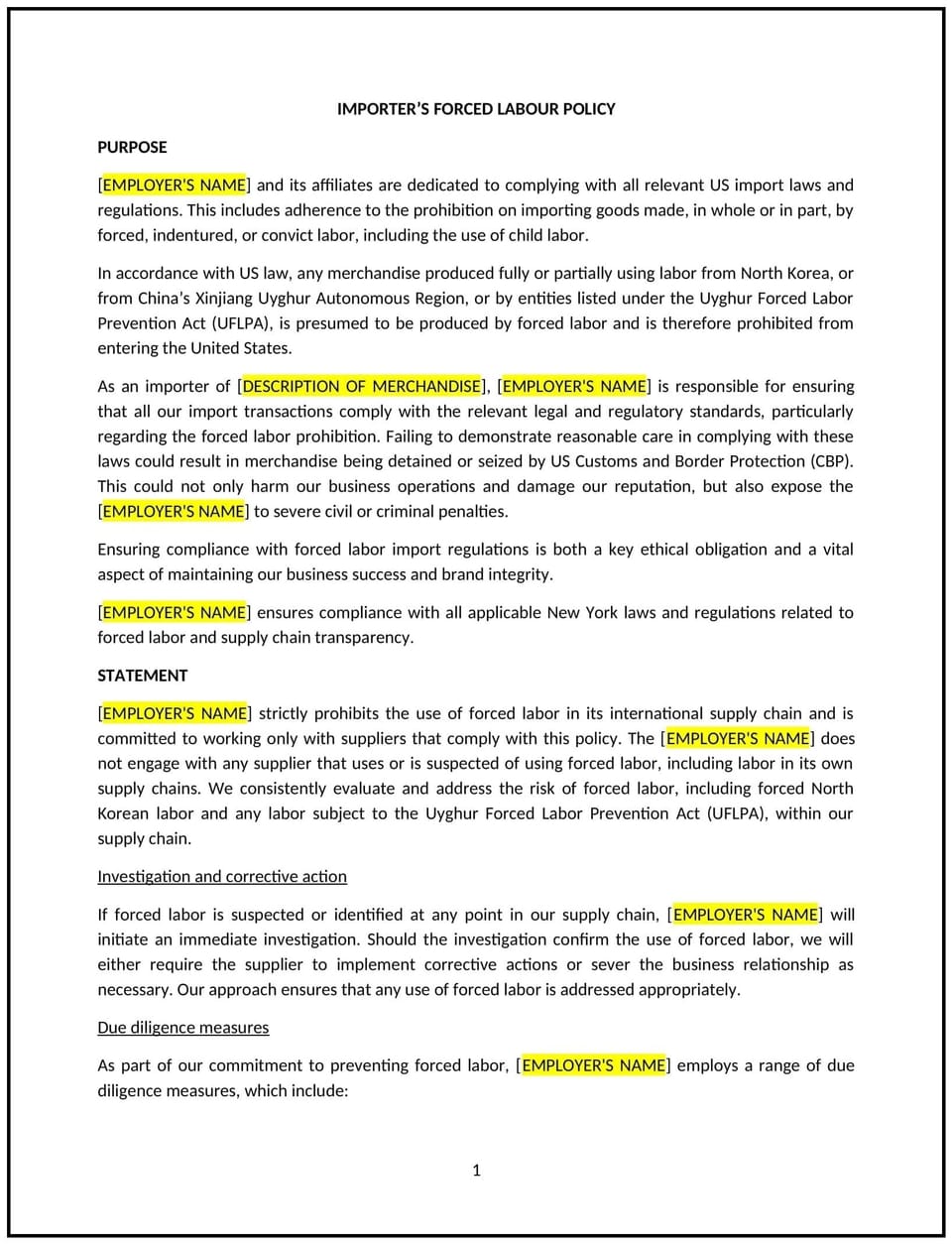Importer's forced labour policy (New York): Free template

Importer’s forced labor policy (New York)
This importer’s forced labor policy is designed to help New York businesses address and mitigate risks related to forced labor in their supply chains. Whether businesses are sourcing goods, managing vendor relationships, or meeting compliance requirements, this template outlines the essential components of a structured approach to uphold ethical sourcing practices.
By using this template, businesses can demonstrate a commitment to ethical labor practices, align with relevant laws, and promote responsible supply chain management.
How to use this importer’s forced labor policy (New York)
- Identify risks in the supply chain: Conduct assessments to identify potential risks of forced labor within supply chains, focusing on high-risk industries or regions.
- Set supplier expectations: Develop a code of conduct for suppliers, outlining prohibited practices related to forced labor and human trafficking.
- Outline due diligence procedures: Describe the steps businesses will take to assess supplier compliance, such as audits, questionnaires, or certifications.
- Define reporting mechanisms: Provide channels for employees, suppliers, or third parties to report concerns about forced labor, including anonymous options.
- Establish remediation processes: Detail how violations will be addressed, such as engaging with suppliers to improve practices or terminating non-compliant relationships.
Benefits of using an importer’s forced labor policy (New York)
This policy offers several benefits for New York businesses:
- Promotes ethical sourcing: A structured policy supports responsible supply chain practices and protects against forced labor risks.
- Reduces reputational risks: Proactive measures help businesses avoid public backlash or scrutiny related to unethical labor practices.
- Improves supplier accountability: Clear expectations and monitoring processes encourage suppliers to align with ethical labor standards.
- Enhances stakeholder trust: Demonstrating a commitment to ethical sourcing fosters trust among customers, investors, and employees.
- Supports compliance efforts: Addressing forced labor risks aligns with state and federal requirements, including customs regulations and trade laws.
Tips for using this importer’s forced labor policy (New York)
- Collaborate with suppliers: Engage with suppliers to build awareness of forced labor risks and encourage adherence to ethical practices.
- Conduct regular assessments: Periodically evaluate supply chain risks and update due diligence procedures to address new challenges or trends.
- Provide training: Offer training sessions for employees and suppliers on identifying and addressing forced labor risks.
- Leverage technology: Use tools such as supply chain mapping or compliance management software to improve visibility and oversight.
- Update regularly: Review the policy to reflect changes in New York trade laws, federal regulations, or international best practices.
Q: What industries are at higher risk for forced labor?
A: Industries such as apparel, agriculture, electronics, and construction are often associated with higher risks of forced labor due to complex global supply chains and vulnerable labor populations.
Q: How can businesses assess supplier compliance?
A: Businesses can conduct on-site audits, review supplier certifications, and use questionnaires to gather information about labor practices.
Q: Are there specific laws addressing forced labor for importers?
A: Yes, federal regulations, such as the U.S. Tariff Act of 1930, prohibit the importation of goods made with forced labor. New York businesses should also monitor relevant state laws and trade requirements.
Q: What should businesses do if forced labor is identified in their supply chain?
A: Businesses can work with the supplier to address the issue through corrective action plans or terminate relationships if improvements are not made.
Q: How often should this policy be reviewed?
A: The policy should be reviewed annually or when significant changes occur in supply chain practices, regulations, or identified risks.
This article contains general legal information and does not contain legal advice. Cobrief is not a law firm or a substitute for an attorney or law firm. The law is complex and changes often. For legal advice, please ask a lawyer.


